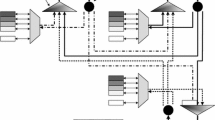Abstract
We consider the issue of bandwidth partitioning in a multi-rate broadband network. Requests for a number of different types of connection are offered to the network. For the purposes of connection admission and resource allocation, we assume that it is possible to allocate an effective bandwidth to a single connection of each type. The network manager has the problem of implementing an admission control scheme to maximise the profit earned from the network. Our focus here is the extent to which it is a good idea to partition the bandwidth on the physical links to form reserved end-to-end logical links corresponding to the origin–destination pairs. It is clear that implementation of such partitioning will lead to a loss of multiplexing opportunities. However, in a network with end-to-end logical links, costs related to overhead such as route selection, admission control and signalling may be much reduced. This effect may outweigh the loss of revenue due to missing out on multiplexing opportunities. We investigate the nature of this trade-off, by designing optimal or near-optimal partitioned networks using efficient algorithms for finding routes and allocating bandwidth to end-to-end logical links on a fixed underlying physical network. We then calculate the net rate of earning profit under each of the schemes as a function of the ratio of overhead costs to call revenue. Our conclusion is that it is cost-effective to partition bandwidth under a variety of realistic assumptions about revenue rates and overhead costs.
Similar content being viewed by others
References
N. Anerousis and A.A. Lazar, Virtual path control for ATMnetworks with call level quality of service guarantees, IEEE ACM Transactions on Networking 6(2) (1998) 222-236.
Å. Arvidsson, S.A. Berezner and A.E. Krzesinski, Virtual path connection management in ATM networks, in: Sixth IFIP Workshop on Performance Modelling and Evaluation of ATM Networks, July 1998, UK.
Å. Arvidsson, S.A. Berezner and A.E. Krzesinski, The design and management of ATM virtual path connection networks, in: Proc. of the 7th Internat. Symposium on Modeling, Analysis, and Simulation of Computer and Telecommunication Systems (MASCOTS'99), College Park, MD, USA, October 1999, pp. 2-9.
Å. Arvidsson, J.M. de Kock, A.E. Krzesinski and P.G. Taylor, The design of ATMvirtual path connection networks with service separation, in: Proc. 8th Internat. Symposium on Modeling, Analysis, and Simulation of Computer and Telecommunication Systems (MASCOTS'2000), San Francisco, USA, September 2000, pp. 424-431.
Å. Arvidsson and A.E. Krzesinski, The design of multi-service MPLS networks for optimal TCP transport, submitted.
N.G. Bean, Effective bandwidths with different quality of service requirements, in: IFIP Transactions, Integrated Broadband Communication Networks and Services, C-18, ed. V.B. Iversen (Elsevier Science, Amsterdam, 1994) pp. 241-252.
N.G. Bean, Dynamic effective bandwidths using network observation and the bootstrap, Australian Telecommunications Research 29(1) (1995) 43-52.
N.G. Bean and P.G. Taylor, Maximal profit dimensioning and tariffing of loss networks, Probability in Engineering and Informational Science 9 (1995) 323-340.
S.A. Berezner and A.E. Krzesinski, Call admission and routing in ATMnetworks based on virtual path separation, in: IFIP TC6/WG6.2, Proc. of the 4th Internat. Conf. on Broadband Communications, eds. P.J. Kuhn and R. Ulrich (Chapman and Hall, Stuttgart, 1998) pp. 461-472.
S.A. Berezner and A.E. Krzesinski, An efficient stable recursion to compute multiservice blocking probabilities, Performance Evaluation 43(2/3) (2001) 151-164.
F. Bonomi, S. Montagna and R. Paglino, A further look at statistical multiplexing in ATM networks, Computer Networks and ISDN Systems 26 (1993) 119-138.
A.I. Elwalid and D. Mitra, Effective bandwidth of general Markovian traffic sources and admission control of high speed networks, IEEE ACM Transactions on Networking 1(3) (1993) 329-343.
A. Faragó, S. Blaabjerg, L. Ast, G. Gordos and T. Henk, A new degree of freedom in ATM network dimensioning: Optimizing the logical configuration, IEEE Journal on Selected Areas in Communications 13(7) (1995) 1199-1206.
J.Y. Hui, Resource allocation for broadband networks, IEEE Journal on Selected Areas in Communications 6(9) (1988) 1598-1608.
J.Y. Hui, Switching and Traffic Theory for Integrated Broadband Networks (Kluwer Academic, Boston, 1990).
F.P. Kelly, Blocking probabilities in large circuit switched networks, Advances in Applied Probability 18 (1986) 473-505.
F.P. Kelly, Loss networks, Annals of Applied Probability 1 (1991) 319-378.
F.P. Kelly, Effective bandwidths at multi-class queues, Queueing Systems 9 (September 1991) 5-16.
K.W. Ross, Multiservice Loss Models for Broadband Telecommunication Networks (Springer, Berlin, 1995).
R. Syski, Congestion Theory in Telephone Systems (Oliver Boyd, Edinburgh/London, 1960).
Y. Takagi, S. Hino and T. Takahashi, Priority assignment control of ATM line buffers with multiple QOS classes, IEEE Journal on Selected Areas in Communications 9(7) (1991) 1078-1092.
W. Whitt, Blocking when service is required from several facilities simultaneously, AT&T Technical Journal 64 (1985) 1807-1856.
W. Whitt, Tail probabilities with statistical multiplexing and effective bandwidths in multi-class queues, Telecommunications Systems 2 (1993) 71-107.
Author information
Authors and Affiliations
Rights and permissions
About this article
Cite this article
Arvidsson, Å., de Kock, J., Krzesinski, A. et al. Cost-Effective Deployment of Bandwidth Partitioning in Broadband Networks. Telecommunication Systems 25, 33–49 (2004). https://doi.org/10.1023/B:TELS.0000011195.92172.74
Issue Date:
DOI: https://doi.org/10.1023/B:TELS.0000011195.92172.74




